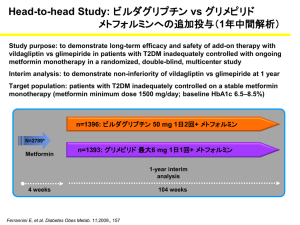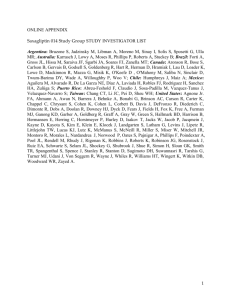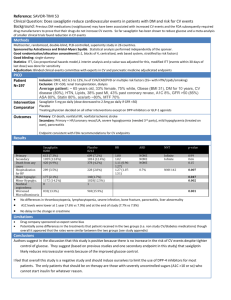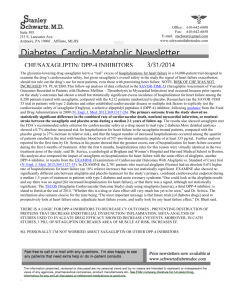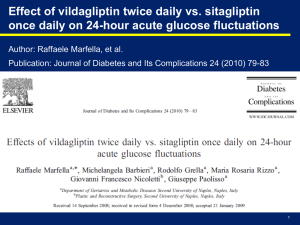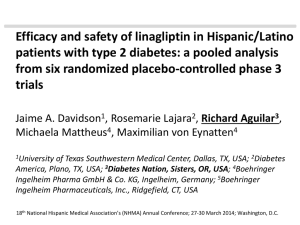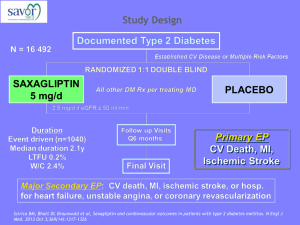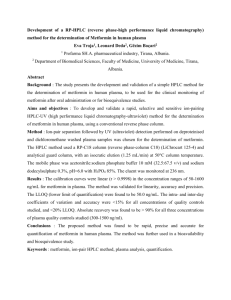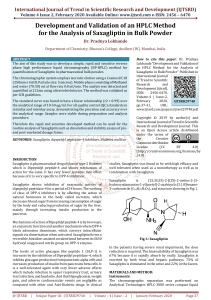Document 13309987
advertisement
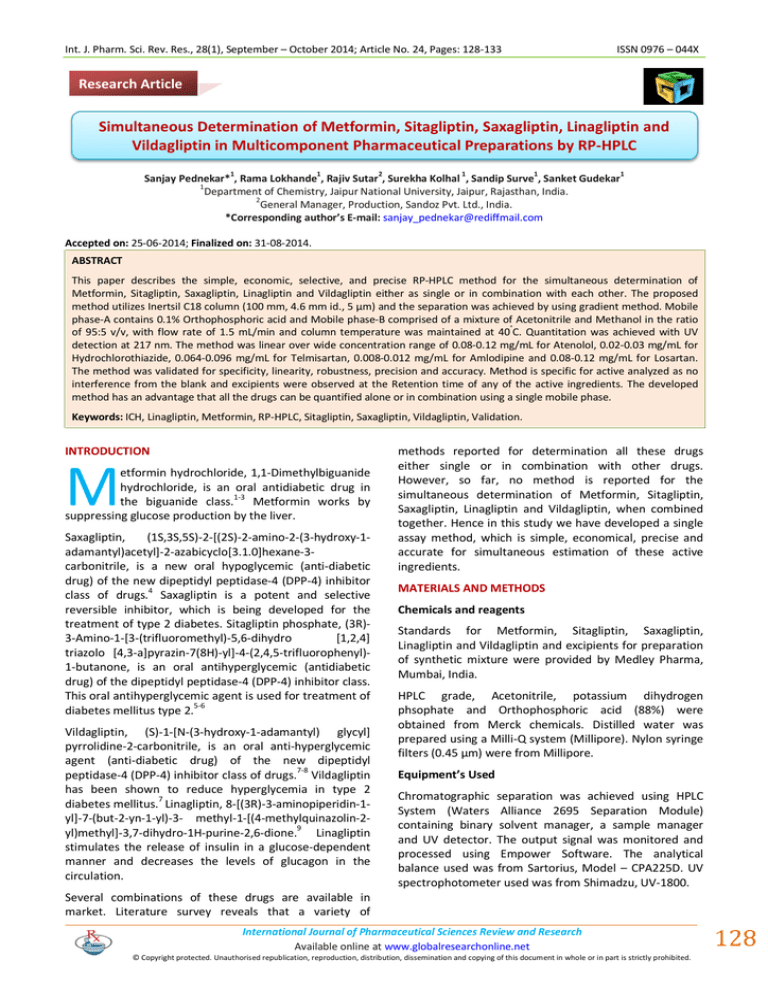
Int. J. Pharm. Sci. Rev. Res., 28(1), September – October 2014; Article No. 24, Pages: 128-133 ISSN 0976 – 044X Research Article Simultaneous Determination of Metformin, Sitagliptin, Saxagliptin, Linagliptin and Vildagliptin in Multicomponent Pharmaceutical Preparations by RP-HPLC 1 1 2 1 1 Sanjay Pednekar* , Rama Lokhande , Rajiv Sutar , Surekha Kolhal , Sandip Surve , Sanket Gudekar 1 Department of Chemistry, Jaipur National University, Jaipur, Rajasthan, India. 2 General Manager, Production, Sandoz Pvt. Ltd., India. *Corresponding author’s E-mail: sanjay_pednekar@rediffmail.com 1 Accepted on: 25-06-2014; Finalized on: 31-08-2014. ABSTRACT This paper describes the simple, economic, selective, and precise RP-HPLC method for the simultaneous determination of Metformin, Sitagliptin, Saxagliptin, Linagliptin and Vildagliptin either as single or in combination with each other. The proposed method utilizes Inertsil C18 column (100 mm, 4.6 mm id., 5 µm) and the separation was achieved by using gradient method. Mobile phase-A contains 0.1% Orthophosphoric acid and Mobile phase-B comprised of a mixture of Acetonitrile and Methanol in the ratio ° of 95:5 v/v, with flow rate of 1.5 mL/min and column temperature was maintained at 40 C. Quantitation was achieved with UV detection at 217 nm. The method was linear over wide concentration range of 0.08-0.12 mg/mL for Atenolol, 0.02-0.03 mg/mL for Hydrochlorothiazide, 0.064-0.096 mg/mL for Telmisartan, 0.008-0.012 mg/mL for Amlodipine and 0.08-0.12 mg/mL for Losartan. The method was validated for specificity, linearity, robustness, precision and accuracy. Method is specific for active analyzed as no interference from the blank and excipients were observed at the Retention time of any of the active ingredients. The developed method has an advantage that all the drugs can be quantified alone or in combination using a single mobile phase. Keywords: ICH, Linagliptin, Metformin, RP-HPLC, Sitagliptin, Saxagliptin, Vildagliptin, Validation. INTRODUCTION M etformin hydrochloride, 1,1-Dimethylbiguanide hydrochloride, is an oral antidiabetic drug in the biguanide class.1-3 Metformin works by suppressing glucose production by the liver. Saxagliptin, (1S,3S,5S)-2-[(2S)-2-amino-2-(3-hydroxy-1adamantyl)acetyl]-2-azabicyclo[3.1.0]hexane-3carbonitrile, is a new oral hypoglycemic (anti-diabetic drug) of the new dipeptidyl peptidase-4 (DPP-4) inhibitor class of drugs.4 Saxagliptin is a potent and selective reversible inhibitor, which is being developed for the treatment of type 2 diabetes. Sitagliptin phosphate, (3R)3-Amino-1-[3-(trifluoromethyl)-5,6-dihydro [1,2,4] triazolo [4,3-a]pyrazin-7(8H)-yl]-4-(2,4,5-trifluorophenyl)1-butanone, is an oral antihyperglycemic (antidiabetic drug) of the dipeptidyl peptidase-4 (DPP-4) inhibitor class. This oral antihyperglycemic agent is used for treatment of 5-6 diabetes mellitus type 2. Vildagliptin, (S)-1-[N-(3-hydroxy-1-adamantyl) glycyl] pyrrolidine-2-carbonitrile, is an oral anti-hyperglycemic agent (anti-diabetic drug) of the new dipeptidyl peptidase-4 (DPP-4) inhibitor class of drugs.7-8 Vildagliptin has been shown to reduce hyperglycemia in type 2 diabetes mellitus.7 Linagliptin, 8-[(3R)-3-aminopiperidin-1yl]-7-(but-2-yn-1-yl)-3- methyl-1-[(4-methylquinazolin-2yl)methyl]-3,7-dihydro-1H-purine-2,6-dione.9 Linagliptin stimulates the release of insulin in a glucose-dependent manner and decreases the levels of glucagon in the circulation. methods reported for determination all these drugs either single or in combination with other drugs. However, so far, no method is reported for the simultaneous determination of Metformin, Sitagliptin, Saxagliptin, Linagliptin and Vildagliptin, when combined together. Hence in this study we have developed a single assay method, which is simple, economical, precise and accurate for simultaneous estimation of these active ingredients. MATERIALS AND METHODS Chemicals and reagents Standards for Metformin, Sitagliptin, Saxagliptin, Linagliptin and Vildagliptin and excipients for preparation of synthetic mixture were provided by Medley Pharma, Mumbai, India. HPLC grade, Acetonitrile, potassium dihydrogen phsophate and Orthophosphoric acid (88%) were obtained from Merck chemicals. Distilled water was prepared using a Milli-Q system (Millipore). Nylon syringe filters (0.45 µm) were from Millipore. Equipment’s Used Chromatographic separation was achieved using HPLC System (Waters Alliance 2695 Separation Module) containing binary solvent manager, a sample manager and UV detector. The output signal was monitored and processed using Empower Software. The analytical balance used was from Sartorius, Model – CPA225D. UV spectrophotometer used was from Shimadzu, UV-1800. Several combinations of these drugs are available in market. Literature survey reveals that a variety of International Journal of Pharmaceutical Sciences Review and Research Available online at www.globalresearchonline.net © Copyright protected. Unauthorised republication, reproduction, distribution, dissemination and copying of this document in whole or in part is strictly prohibited. 128 © Copyright pro Int. J. Pharm. Sci. Rev. Res., 28(1), September – October 2014; Article No. 24, Pages: 128-133 ISSN 0976 – 044X Selection of UV wavelength Preparation of Placebo solution 10ppm solution of each Metformin, Sitagliptin, Saxagliptin, Linagliptin and Vildagliptin was prepared separately in methanol. UV scan of the above solutions were carried out over a wavelength range of 200–400 nm by using the Shimadzu UV spectrophotometer, ModelUV-1800. The detection wavelength was set at 232 nm because all the components exhibited higher responses. Placebo was prepared with excipients containing Starch, Lactose, Crospovidone, PVPK 30, Aerosil and Magnesium stearate. HPLC instruments and analytical conditions An Inertsil C18 column (100 mm X 4.6 mm id and 5 µm particle size) was used as the stationary phase. Mobile phase A, Phosphate Buffer pH 3.0 and Mobile Phase B, Acetonitrile with simple gradient programme(0-3 min :: MP-A : 85:85; 3-8 min :: MP-A : 85-50; 8-10min :: MP-A : 50-50; 10-15 min :: MP-A : 50-30; 15-25 min :: MP-A : 3085) was delivered at a flow rate of 1.0 mL/min. The column temperature was kept at 25°C. The detector was set at the wavelength of 232 nm. Injection volume kept was 5 µL. Sample and standard preparation was done in a Solvent mixture was prepared using Acetonitrile and water in the ratio of 50:50 v/v. Placebo equivalent to 1 tablet was weighed and transferred to 100 mL volumetric flask. Added 50 mL of diluent to this mixture and sonicated the solution for approximately 10 minutes. Cooled to room temperature and diluted to the mark with diluent. 5 mL aliquot of this sample stock solution was transferred to 50 mL volumetric flask and diluted to the mark with diluent to obtain placebo solution. The solution was filtered through Nylon 0.45 µm membrane filter. 5 µL of this placebo solution was injected in HPLC System. Calculation All active ingredients were quantified with the following calculation: Sample Area x Standard dilution factor x 100 % Assay = --------------------------------------------------------Standard area x Sample dilution factor Solutions and sample preparation Method Validation Preparation of standard solution The developed RP-HPLC method was validated as per International Conference on Harmonization (ICH) Guideline, Validation of Analytical Procedures: Q2(R1), for the parameters like system suitability, linearity and range, precision (repeatability), intermediate precision (ruggedness), specificity, accuracy and robustness.11-12 A stock solution of Metformin (5.00 mg/mL), Vildagliptin (0.50 mg/mL), Sitagliptin (0.50 mg/mL), Saxagliptin (0.05 mg/mL), and Linagliptin (0.05 mg/mL) was prepared by dissolving an appropriate amount of the active substances in a solvent mixture. Working solutions of different concentrations for Metformin (0.50 mg/mL), Vildagliptin (0.050 mg/mL), Sitagliptin (0.050 mg/mL), Saxagliptin (0.005 mg/mL) and Linagliptin (0.005 mg/mL) were prepared from the above stock solution and diluted with the solvent mixture. Preparation of Sample solutions A Formulation containing all these actives is not available in market. Hence Synthetic mixture containing all these actives at the concentration level available in its individual or combined marketed formulation was prepared. To these actives, the basic excipients were 10 added. Synthetic mixture equivalent to 1 tablet was weighed and transferred to 100 mL volumetric flask. Added 50 mL of diluent to this mixture and sonicated the solution for approximately 10 minutes. Cooled to room temperature and diluted to the mark with diluent. 5 mL aliquot of this sample stock solution was transferred to 50 mL volumetric flask and diluted to the mark with diluent to obtain a test solution of Metformin (0.50 mg/mL), Vildagliptin (0.050 mg/mL), Sitagliptin (0.050 mg/mL), Saxagliptin (0.005 mg/mL) and Linagliptin (0.005 mg/mL). The solution was filtered through Nylon 0.45 µm membrane filter. 5 µL of this synthetic mixture solution was injected in HPLC System. System suitability The system suitability test performed according to USP36. [13] The standard solution was injected six times and results were recorded to find the adequate peak separation (resolution), percentage relative standard deviation for area, retention time, symmetry factor and theoretical plates. The results obtained were compiled in Table 1. Specificity Specificity was performed to detect the presence of interfering peak (blank and placebo peaks) at the retention time of the analyte peak. The specificity of the method was checked by comparison of chromatograms obtained from synthetic mixture and the corresponding placebo. The interference of excipients was detected by preparing placebo solution equivalent to about the weight in proportion of synthetic mixture preparation as per the test method and was injected into the HPLC system. The interference of blank was detected by injecting diluent as per the test method. The representative chromatogram obtained for standard solution is shown in Figure 1. International Journal of Pharmaceutical Sciences Review and Research Available online at www.globalresearchonline.net © Copyright protected. Unauthorised republication, reproduction, distribution, dissemination and copying of this document in whole or in part is strictly prohibited. 129 © Copyright pro Int. J. Pharm. Sci. Rev. Res., 28(1), September – October 2014; Article No. 24, Pages: 128-133 ISSN 0976 – 044X Table 1: System suitability – Percentage relative standard deviation for area and Retention time Metformin Vildagliptin Sitagliptin Saxagliptin Linagliptin 0.47 0.87 0.70 0.72 0.09 0.12 2.6 21.2 1.1 1.1 62290 62345 Reference solution Peak Area for n=6 % RSD 0.26 Acceptance Criteria Not more than 2.0% Reference solution Peak retention time (min), for n=6 % RSD 0.17 0.11 0.07 Acceptance Criteria Not more than 1.0% Reference solution Peak Resolution , for n=6 Resolution - 16.2 11.3 Acceptance Criteria Not less than 2.0 Reference solution Peak Symmetry Factor, for n=6 Symmetry Factor 1.1 1.1 1.2 Acceptance Criteria Should be between 0.8 – 1.2 Reference solution Peak Theoretical plates, for n=6 Theoretical plates 4604 35270 59300 Acceptance Criteria Not less than 2000 Table 2: Precision and Intermediated precision results Metformin Vildagliptin Sitagliptin Saxagliptin Linagliptin Average Assay (%) 98.1 97.9 99.9 98.2 98.5 %RSD 0.47 0.38 1.65 1.01 0.70 Average Assay (%) 99.0 98.6 100.4 98.3 99.9 Precision (Day 1) –Assay % Intermediate Precision (Day 2) – Assay % % RSD 0.62 0.47 2.36 0.57 1.63 Average Assay for Precision and Intermediate Precision 98.5 98.2 100.1 98.2 99.2 % RSD for Precision and Intermediate Precision 0.69 0.55 1.97 0.79 1.39 Acceptance Criteria %RSD should not be more than 2.0% for day-1 and day-2. Table 3: Summary of Linearity and range results in assay method for simultaneous determination of Metformin, Vildagliptin, Saxagliptin, Sitagliptin and Linagliptin Active Ingredient Concentration Range (mg/mL) correlation coefficient %Y Intercept Slope Metformin 0.4-0.6 1.000 1.39 14547103 Vildagliptin 0.04-0.06 0.998 2.52 17687703 Sitagliptin 0.04-0.06 0.999 3.07 21152647 Saxagliptin 0.004-0.006 1.000 2.41 241229842 Linagliptin 0.004-0.006 1.000 0.35 63354813 Precision and Ruggedness (Intermediate precision) Linearity and range Method precision was evaluated by injecting six different sample preparation of synthetic mixture. Different analyst from the same laboratory evaluated the intermediate precision of the method. The assay of these samples was determined. Precision and intermediate precision of the method was evaluated by calculating the %RSD. The values were given in Table 2. The linearity of detector response was determined by preparing a series of solution of the working standards (mixture of all active ingredients) over the range of 80% to 120% of targeted concentration. These solutions were injected into the chromatographic system and response area was recorded. Calibration curve was constructed by plotting area against concentration and regression International Journal of Pharmaceutical Sciences Review and Research Available online at www.globalresearchonline.net © Copyright protected. Unauthorised republication, reproduction, distribution, dissemination and copying of this document in whole or in part is strictly prohibited. 130 © Copyright pro Int. J. Pharm. Sci. Rev. Res., 28(1), September – October 2014; Article No. 24, Pages: 128-133 ISSN 0976 – 044X equation was computed. The values were given in Table 3. (spiking method) at the level of 80%, 100% and 120% of targeted concentration. The recovery samples were prepared in triplicate at each level. The contents were Accuracy (Recovery) determined from the respective chromatograms. The To study the accuracy of the method recovery samples at different levels were chromatographed and experiments were carried out. The accuracy of the test the percentage recovery for the amount added was method was determined by preparing recovery samples calculated. The values were given in Table 4. Table 4: Accuracy (Recovery) Active Ingredient Name Concentration (%) Amount Added ( mg/mL) Amount found ( mg/mL)* Mean Recovery (%)** 80 0.080 0.084 103.7 100 0.100 0.105 101.8 120 0.120 0.127 104.1 80 0.020 0.020 102.6 100 0.025 0.025 102.1 120 0.030 0.031 103.2 80 0.064 0.065 104.8 100 0.080 0.081 100.0 120 0.096 0.097 104.6 80 0.008 0.008 102.3 100 0.010 0.010 101.7 120 0.012 0.012 102.8 80 0.080 0.080 103.6 100 0.100 0.099 101.9 120 0.120 0.120 103.8 Metformin Vildagliptin Sitagliptin Saxagliptin Linagliptin Acceptance criteria Average Recovery (%) 103.2 102.6 103.1 102.3 103.1 The mean and individual recoveries should be within 95.0 – 105.0% * mean of 3 readings for individual level; ** Average recovery for all levels Table 5: Robustness results (Resolution, symmetry factor and Theoretical plates) Summary of system suitability Parameters Resolution Variations Symmetry Factor Theoretical plates Met Vil sit sax Lin Met Vil sit sax Lin Met Vil sit sax Lin 1.5 mL/min 25°C - 16.1 11.4 2.6 21.7 1.05 1.09 1.19 1.11 1.06 4599 36433 59533 62708 66152 20°C - 16.5 11.3 2.7 21.6 1.06 1.21 1.19 1.16 1.12 4696 35345 58346 62268 62864 30°C - 16.2 11.0 2.3 21.1 1.04 1.15 1.04 1.06 1.11 4864 35674 59235 62386 64328 0.9 mL/min - 16.6 11.8 2.7 21.4 1.2 1.1 1.37 1.2 1.05 4873 34368 58964 61468 61584 1.1 mL/min - 16.1 11.4 2.3 21.1 1.03 1.14 1.28 1.1 1.06 4632 34984 58982 69326 63217 Acceptance Criteria Not less than 2.0 Should be between 0.8 – 1.2 Not less than 2000 Met: Metformin; Vil: Vildagliptan; Sit: Sitagliptan; Sax: Saxagliptin; Lin: Linagliptin Robustness-Effect of variation in Temperature and variation in flow rate Small, deliberate changes were made to the chromatographic condition. A study was performed to determine the effect of variation in the temperature and flow rate. Standard solution prepared as per the test method and was injected into the HPLC system at 20°C and 30°C temperature. Flow rate change was done by varying flow rate at from 1.0 mL/min to 0.9 mL/min and 1.1 mL/min. The system suitability parameters were evaluated. The values were given in Table 5. Solution Stability To study solution stability, reference standard and test solutions were stored at ambient condition for 25 °C for 24 hours, and injected in HPLC system at predetermined time interval. The percentage change with respect to initial for test and reference solutions were evaluated. The values were given in Table 6. RESULTS AND DISCUSION The RP-HPLC method was developed for the simultaneous estimation of Metformin, Sitagliptin, Saxagliptin, International Journal of Pharmaceutical Sciences Review and Research Available online at www.globalresearchonline.net © Copyright protected. Unauthorised republication, reproduction, distribution, dissemination and copying of this document in whole or in part is strictly prohibited. 131 © Copyright pro Int. J. Pharm. Sci. Rev. Res., 28(1), September – October 2014; Article No. 24, Pages: 128-133 Linagliptin and Vildagliptin in bulk drug and synthetic mixture prepared (as per tablet formulation) and validated as per ICH guidelines for the parameters: system suitability, linearity and range, precision (repeatability), intermediate precision (ruggedness), ISSN 0976 – 044X specificity, accuracy and robustness. The observations and results obtained for each of the parameters lies well within the acceptance criteria. The developed method is simple, specific, linear, precise, accurate, robust and rugged. Table 6: Solution Stability results Test Solution - Solution stability Time in H Area of Met % Change w.r.t. initial Area of Vil % Change w.r.t. initial Initial 99.9 0.00 100.2 0.00 100.1 0.00 99.7 0.00 99.5 0.00 6 99.5 0.40 100.0 0.19 99.3 0.85 99.6 0.14 99.6 0.01 12 100.6 0.64 100.1 0.14 98.8 1.31 99.5 0.23 99.6 0.07 18 99.6 0.34 100.7 0.45 98.9 1.20 98.1 1.65 99.3 0.21 24 100.1 0.22 99.9 0.32 98.8 1.27 98.0 1.70 99.6 0.10 Acceptance Area of Sit % Change w.r.t. initial Area of Sax % Change w.r.t. initial Area of Lin % Change w.r.t. initial % Change w.r.t. initial for Test solution should NMT 2% of initial assay results. Criteria Reference Solution - Solution stability Time in H Area of Met % Change w.r.t. initial Area of Vil % Change w.r.t. initial Area of Sit % Change w.r.t. initial Area of Sax % Change w.r.t. initial Area of Lin % Change w.r.t. initial Initial 7674976 0.00 946674 0.00 1135372 0.00 1289627 0.00 333298 0.00 6 7664389 0.14 945693 0.10 1132881 0.22 1288765 0.07 331092 0.66 12 7667823 0.09 945349 0.14 1131956 0.30 1287209 0.19 331621 0.50 18 7664096 0.14 944998 0.18 1129873 0.48 1286096 0.27 331009 0.69 24 7659983 0.20 944720 0.21 1129006 0.56 1285982 0.28 331283 0.60 Acceptance Criteria % Change w.r.t. initial for reference solution should NMT 2% of initial. Met: Metformin; Vil: Vildagliptan; Sit: Sitagliptan; Sax: Saxagliptin; Lin: Linagliptin Figure 1: Typical Chromatograms of Combined Standard Solution containing Saxagliptin, Sitagliptin, Vildagliptin, Metformin and Linagliptin. System suitability parameters proved that the proposed method suits for the simultaneous estimation of Metformin, Sitagliptin, Saxagliptin, Linagliptin and Vildagliptin. Chromatogram for Metformin, Sitagliptin, Saxagliptin, Linagliptin and Vildagliptin was found satisfactory on Inertsil C18, 5µm, 100 mm x 4.6 mm. No interference from diluent, excipients or any other peak was found at the retention time of Metformin, Sitagliptin, Saxagliptin, Linagliptin and Vildagliptin. Drug peaks were found symmetrical as observed from asymmetry factor. Resolution of the proposed method was satisfactory. Sensitivity of the method was good and also linearity was observed over a wide concentration range of 0.4-0.6 mg/ml for Metformin, 0.04-0.06 mg/ml for Vildagliptin, 0.04- 0.06 mg/ml for Sitagliptin, 0.004-0.006 mg/ml for Saxagliptin and 0.004-0.006 mg/ml for Linagliptin. The correlation coefficients for individual analytes were within the limit 0.998 and Y-intercept values were within ± 3 %. Accuracy of the method was determined by recovery with spiked concentration of pure drug at three levels for Metformin, Sitagliptin, Saxagliptin, Linagliptin and Vildagliptin. Recovery of drug was well within the acceptance limits of 95.0-105.0%. %RSD obtained from the precision results was less than 2.0% for day – 1 and day -2. From variation in Temperature and flow rate, it was observed that there were no marked changes obtained in the chromatograms, which demonstrated that the method developed is robust. Resolution, symmetry factor and Theoretical plate limits for flow rate variation and temperature variation are within the acceptance criteria, which show that the method exhibit good system suitability under given set of conditions. Both Test and reference solution was found to be stable up to 24hours, at 25°C (laboratory temperature). International Journal of Pharmaceutical Sciences Review and Research Available online at www.globalresearchonline.net © Copyright protected. Unauthorised republication, reproduction, distribution, dissemination and copying of this document in whole or in part is strictly prohibited. 132 © Copyright pro Int. J. Pharm. Sci. Rev. Res., 28(1), September – October 2014; Article No. 24, Pages: 128-133 AQ, Zeng W, Musson D, Winchell G, Davies MJ, Ramael S, Gottesdiener KM, Wagner JA (December 2005), "Pharmacokinetics and pharmacodynamics of sitagliptin, an inhibitor of dipeptidyl peptidase IV, in healthy subjects: results from two randomized, double-blind, placebocontrolled studies with single oral doses", Clin Pharmacol Ther, 78(6), 675–688. CONCLUSION The RP-HPLC method developed for quantitative determination of Metformin, Sitagliptin, Saxagliptin, Linagliptin and Vildagliptin is novel, rapid, precise, accurate and selective and is suitable for its intended purpose. The method was validated as per ICH guidelines, showing satisfactory data for all the method validation parameters tested. The developed method was found “specific” to the drug and for the dosage form, as the peaks of the excipient did not interfere with the drug peak. Hence, the proposed method can be employed for assessing the quantitative determination of Metformin, Sitagliptin, Saxagliptin, Linagliptin and Vildagliptin in as a bulk drug and also for its dosage form. 6. National Prescribing Service (August 2010), "Sitagliptin for Type 2 Diabetes” Retrieved 27 August 2010. 7. Ahrén B, Landin-Olsson M, Jansson PA, Svensson M, Holmes D, Schweizer A, "Inhibition of dipeptidyl peptidase4 reduces glycemia, sustains insulin levels, and reduces glucagon levels in type 2 diabetes", The Journal of Clinical Endocrinology and Metabolism, 89(5), 2004, 2078–2084. 8. Mentlein R, Gallwitz B, Schmidt WE, "Dipeptidyl-peptidase IV hydrolyses gastric inhibitory polypeptide, glucagon-like peptide-1(7-36)amide, peptide histidine methionine and is responsible for their degradation in human serum", European journal of biochemistry / FEBS, 214(3), 1993, 829–835. 9. "FDA Approves Type 2 Diabetes Drug from Boehringer Ingelheim and Lilly", 3 May 2011. 10. Raymond CR, Paul JS, Marian EQ, Handbook of th Pharmaceutical Excipients 6 ed. Royal Pharmaceutical Society of Great Britain, London, 2009. 11. International Conference Harmonization on ICH Q2 R1: Validation of Analytical Procedures—Test and Methodology, Geneva, Switzerland, 2005. 12. Reviewer Guidance: Validation of Chromatographic Methods. Center for Drug, Evaluation and Research (CDER), Washington, 1994. 13. The United State Pharmacopeia, 36th ed., United State Pharmacopeia Convention, System Suitability Testing, Rockville, USA. REFERENCES 1. 2. Clinical Guidelines Task Force, International Diabetes Federation (2005). "Glucose control: oral therapy” PDF (100 KB), In: Global Guideline for Type 2 Diabetes. Brussels: International Diabetes Federation, 35–8. Retrieved November 6, 2007. National Collaborating Centre for Chronic Conditions. Type 2 diabetes: national clinical guideline for management in primary and secondary care (update). London: Royal College of Physicians, 2008. ISBN 978-1-86016-333-3, 86. 3. American Diabetes Association, Standards of medical care in diabetes—2009, Diabetes Care, 32 Suppl 1, S13–61. 4. Augeri D et al., "Discovery and preclinical profile of Saxagliptin (BMS-477118): a highly potent, long-acting, orally active dipeptidyl peptidase IV inhibitor for the treatment of type 2 diabetes", Journal of Medicinal Chemistry, 48(15), 2005, 5025–5037. 5. Herman GA, Stevens C, Van Dyck K, Bergman A, Yi B, De Smet M, Snyder K, Hilliard D, Tanen M, Tanaka W, Wang ISSN 0976 – 044X Source of Support: Nil, Conflict of Interest: None. International Journal of Pharmaceutical Sciences Review and Research Available online at www.globalresearchonline.net © Copyright protected. Unauthorised republication, reproduction, distribution, dissemination and copying of this document in whole or in part is strictly prohibited. 133 © Copyright pro
